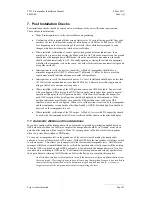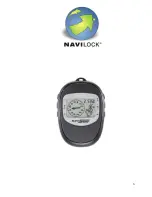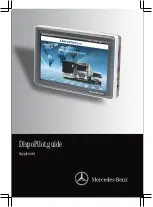
TT31 Transponder Installation Manual
8 May 2017
00455-00
Issue AQ
______________________
Page 8
Trig Avionics Limited
5. Installation
5.1 Unpacking and Inspecting Equipment
Carefully unpack the transponder and make a visual inspection of the unit for evidence of any damage
incurred during shipment. If the unit is damaged, notify the shipping company to file a claim for the
damage. To justify your claim, save the original shipping container and all packaging materials.
5.2 Mounting
The TT31 Mode S transponder must be mounted rigidly in the aircraft panel. The following installation
procedure should be followed, remembering to allow adequate space for installation of cables and
connectors.
•
Select a position in the panel that is not too close to any high external heat source. (The TT31
is not a significant heat source itself and does not need to be kept away from other devices for
this reason).
•
Avoid sharp bends and placing the cables too near to the aircraft control cables.
•
Secure the mounting tray (p/n 00231-00) to the instrument panel via the six (6) mounting
holes in the tray. It is important that the tray is supported at the rear two mounting holes as
well as the front four.
•
Check that the locking mechanism is correctly oriented by unscrewing the locking screw if
required.
•
Slide the TT31 transponder into the secured mounting tray.
•
Lock the TT31 transponder into the mounting tray using a 3/32” Allen key, taking care not to
over tighten the locking screw.
5.3 Cooling Requirements
The TT31 Mode S transponder meets all applicable ETSO and TSO requirements without forced air-
cooling.
Attention should however be given to the incorporation of cooling provisions to limit the maximum
operating temperature of each unit when the TT31 is installed in a typical panel or rack. The reliability
of equipment operating in close proximity in a rack can be degraded if adequate cooling is not
provided.
5.4 Electrical Connections
The TT31 has two Molex edge connectors, one with 24 contacts, which is the primary interface, and a
second connector with 12 contacts. A single coaxial connector attaches to the antenna. The second
Molex connector (12 way connector) adds the altitude alerter, an ARINC 429 output, audio output,
audio mute input and a second serial port. In simple installations it is possible to omit wiring for the
second connector altogether.
The Molex edge connector used in the TT31 is similar to the connector used on the KT76A, KT76C
and KT78A transponders, and the common signals on the primary connector use the same contact
positions and are electrically compatible. The antenna connector is also compatible. Providing that the
wiring is appropriately installed, it is intended that you can upgrade a KT76A, KT76C or KT78A
installation to the TT31 without any connector rewiring. Before doing that however, you MUST check
that the wiring for the existing transponder is in good condition.















































